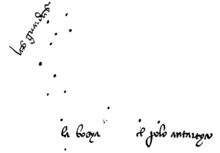Crux
Crux (/krʌks/) is a constellation of the southern sky that is centred on four bright stars in a cross-shaped or kite-like asterism commonly known as the Southern Cross. It lies on the southern end of the Milky Way's visible band. The name Crux is Latin for cross. Even though it is the smallest of all 88 modern constellations, Crux is among the most easily distinguished as its four main stars each have an apparent visual magnitudebrighter than +2.8. It has attained a high level of cultural significance in many Southern Hemisphere states and nations.
Blue-white α Crucis (Acrux) is the most southerly member of the constellation and, at magnitude 0.8, the brightest. The three other stars of the cross appear clockwise and in order of lessening magnitude: β Crucis (Mimosa), γ Crucis (Gacrux), and δ Crucis (Imai). ε Crucis (Ginan) also lies within the cross asterism. Many of these brighter stars are members of the Scorpius–Centaurus Association, a large but loose group of hot blue-white stars that appear to share common origins and motion across the southern Milky Way.
Crux contains four Cepheid variables, each visible to the naked eye under optimum conditions. Crux also contains the bright and colourful open cluster known as the Jewel Box (NGC 4755) on its western border. Nearby to the southeast is a large dark nebula spanning 7° by 5° known as the Coalsack Nebula, portions of which are mapped in the neighbouring constellations of Centaurus and Musca.
The bright stars in Crux were known to the Ancient Greeks, where Ptolemy regarded them as part of the constellation Centaurus.[1][2] They were entirely visible as far north as Britain in the fourth millennium BC. However, the precession of the equinoxes gradually lowered the stars below the European horizon, and they were eventually forgotten by the inhabitants of northern latitudes.[3] By 400 CE, the stars in the constellation now called Crux never rose above the horizon throughout most of Europe. Dante may have known about the constellation in the 14th century, as he describes an asterism of four bright stars in the southern sky in his Divine Comedy.[4][5] His description, however, may be allegorical, and the similarity to the constellation a coincidence.[6]
The 15th century Venetian navigator Alvise Cadamosto made note of what was probably the Southern Cross on exiting the Gambia River in 1455, calling it the carro dell'ostro ("southern chariot"). However, Cadamosto's accompanying diagram was inaccurate.[7][8] Historians generally credit João Faras[a] for being the first European to depict it correctly. Faras sketched and described the constellation (calling it "Las Guardas") in a letter written on the beaches of Brazil on 1 May 1500 to the Portuguese monarch.[9][10]
Explorer Amerigo Vespucci seems to have observed not only the Southern Cross but also the neighboring Coalsack Nebula on his second voyage in 1501–1502.[11]

